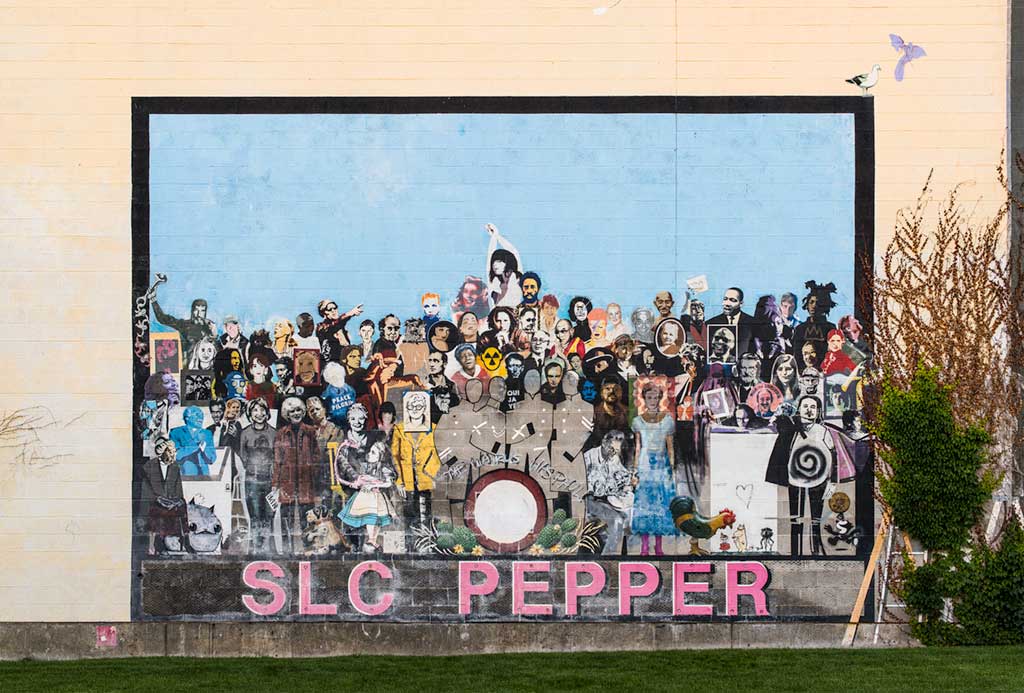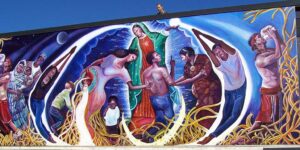
Jann Haworth, ’SLC Pepper’ mural (downtown Salt Lake City).(Courtesy Chad Kirkland Photography)
By Scotti Hill in Utah

As a state, Utah conjures two predominant associations: Mormonism and mountains. Maybe parks and monuments too. But Salt Lake City, one of the youngest and fastest–growing metro areas in the nation, is today animated by a vibrant counterculture, overflowing with coffee shops, microbreweries, and community murals. Utah boasts a thriving arts community in SLC and in rural pockets throughout the state. At the same time, Utah’s artists and institutions face obstacles common to smaller art markets.
Those challenges are well-documented: less state funding, smaller collector base, cutbacks to regional publications, a drive toward online ‘click-bait’, and fewer venues for exhibiting work. Salt Lake faces serious inequities caused by gentrification, and the devastating fallout from COVID-19. Despite or because of these struggles, notable threads of an artistic identity have emerged in unexpected ways. Utah also has growing communities of color, and an LGBTQ population that ranks as the seventh highest in the nation. Diverse artists and their allies continually seek ways to amplify these voices, along with new innovators in the arts, in a state that has long been majority white, and religiously conservative.
Utah’s expansive topography bears witness to a history of Mormon pioneers displacing the native Ute tribe, from whom the state claimed its name. The white, masculinist settler ideologies of Manifest Destiny and abundant, conquerable land have left their imprint on a history of Western art. Today’s Utah artists and arts professionals grapple with and challenge this legacy. But they also seek to move beyond traditional forms of Western art, pushing their practices forward, and developing venues and an ecosystem that will represent Utah’s future.
“So much of building an arts community is about constructing a critical mass for buy-in, an infrastructure of a creative community, for makers and creators,” says Amy Jorgensen, executive director and chief curator of Granary Arts, located two hours south of Salt Lake City in Ephraim, Utah. Housed in an 18th-century granary built by Mormon pioneers, Granary has proved an incubator of critical dialogue for Utah artists. In 2019, Jorgensen, in partnership with art professor Ed Bateman and the University of Utah’s Red Butte Press, crafted an indispensable portfolio and collection of essays, De-Marcation: A Survey of Contemporary Photography in Utah. The collection and its traveling exhibition showcased 20 Utah artists whose works create new frontiers for Utah’s art.
Utah’s dramatic natural landscapes inspired what are perhaps its most famous artworks: the Land Art masterpieces of Robert Smithson’s Spiral Jetty (1970), on the shores of the Great Salt Lake, and his partner Nancy Holt’s Sun Tunnels (1973-76), near the ghost town of Lucin. The Utah Museum of Fine Art, the state’s flagship museum, has for decades fostered education and scholarship about the state’s Land Art treasures, and it has produced urgent initiatives and traveling exhibitions like Our America: The Latino Presence in American Art (2015), a blockbuster which showcased over 60 artists throughout the 20th century.
Determined to escape the pigeonhole of Western art, Utah artists also create work with a national audience in mind. The Utah Museum of Contemporary Art helps ambitious local artists forge a distinct conversation that responds to larger national trends. UMOCA’s recent exhibition Abstraction is Just a Word, But I Use It (2019-2020), for example, showcased the fascinating array of Utah’s experimental and abstract art. Indeed, the artists transforming contemporary art in Utah are plentiful: the bending geometric illusions of David LeCheminant; Nancy Rivera’s photographic renderings of art historical still-lifes; the floating spacemen and rich layers of collage in Andrew Rice’s work; Lenka Konopasek’s gargantuan paper sculptures; Horacio Rodriguez’ subversive, repurposed object-sculptures; Cara Krebs’ uncanny sculptural oddities; the crowded and lively installations of Frank McEntire; Trent Alvey’s illuminating light sculptures; Jiyoun Lee-Lodge’s sumptuously detailed drawings; the flirtation of release and control in the abstract paintings of Nolan Flynn; the mixed-media intricacies and technical detail of Jacqui Larsen’s collages—and many others.
Several notable local galleries, like Modern West Fine Art and Nox Contemporary, promote these artists who otherwise struggle to find exhibition sites beyond a modest roster of committed spaces. It is equally challenging for them to connect with collectors who could support their practices. Some commercial galleries continue to tout tourist-friendly desert arches and snowy scenes for Sundance Festival goers. As in any market, Utah needs collectors to fuel new trends in contemporary practice.

“The biggest challenges facing Utah artists are opportunities for exhibiting and selling their work,” says Jorge Rojas, multimedia artist and director of learning and engagement at UMFA. “It’s back to the problem that there is no real market here to speak of and there is a shortage of venues showing local artists. I realize that it’s no different here than any other city, which is the point. The art market in this country is not designed to support artists, it’s designed to commodify the arts so that a minuscule percentage of artists become art stars and everyone else struggles to pay the rent.”
In response, Utah artists have used their creativity to construct alternative venues, building artist-run collectives, situated in residences or noncommercial spaces such as Washer/Dryer Projects and Openroom.
Though artists enjoy comradeship from working in an inclusive art scene, they often bemoan the lack of attention that their work receives from local publications. Although 15 Bytes: Utah‘s Art Magazine and Salt Lake Underground (SLUG Magazine) play a vital role in arts coverage and criticism, the state’s newspaper arts reporting has drastically decreased in recent years. But mere coverage of the arts is not enough. Artists, viewers, and collectors crave a more robust circle of critics who can evaluate Utah’s art in connection with larger national and global trends.
Utah is also working to build initiatives designed to bolster inclusiveness, diversity, and emerging figures in the arts community. Initially performed at SLC’s annual Performance Art Festival in 2016, Rojas’s Hands Up, Don’t Shoot! invites participants to respond bodily to that vocal proclamation. It considers the violence of racial profiling and police brutality as a “response to the continued inhumane, institutionalized violence against black and brown lives in the United States,” according to Rojas. The work resonates now more than ever; as of this writing, SLC and the nation are reeling from, and protesting against, the fatal consequences of systemic police violence against African Americans, and other marginalized constituencies.
Rojas’ art, advocacy, and educational initiatives complement those of influential grassroots organizations on SLC’s west side, like Utah Arts Alliance, Art Access, Sugarspace, and Mestizo Institute of Culture and Arts (MICA), which is devoted to art and activism. Once located inside a neighborhood coffeehouse, MICA has launched significant exhibitions of minority artists and enriched Salt Lake City with the visions of curators Renato Olmedo-Gonzalez and Jendar Morales-Collazo.
Though state funding is limited, Utah’s Division of Arts and Museums provides crucial public support for artists and institutions, supplying curatorial and development grants for artists, maintaining a state collection, and operating the Alice and Rio galleries.

Additionally, Salt Lake City is devising new programs to promote culturally diverse artists within the state and make their work accessible for various populations. “Our current mayor, Erin Mendenhall, has prioritized gentrification–mitigation and equity and inclusion, both of which include arts as a way to facilitate these goals,” says Felicia Baca, executive director of the Salt Lake City Arts Council. The city incentivizes what Baca calls “a more robust public art policy, [which dedicates] additional dollars to public art, expands notions of public art as temporary and placemaking based, and incentivizes private property owners to include art in their developments.” One such initiative is ‘Tickets for Transit,’ which enables travelers to use transit passes as entrance tickets to regional arts, culture, and sporting events.
Women like Baca play a crucial role in the development of Utah’s art scene. Gretchen Dietrich and Laura Hurtado are the executive directors of the Utah Museum of Fine Art and the Utah Museum of Contemporary Art, respectively; Whitney Tassie is senior curator at UMFA; Lydia Gravis is the director of the Mary Elizabeth Dee Shaw Gallery at Weber State University, in Ogden; and Jessica Kinsey is museum director and curator at Southern Utah University’s Southern Utah Museum of Art. Many art galleries and spaces are helmed by female leaders, including Julie Nester Gallery, Phillips Gallery, Granary, Luminaria, and Modern West.
Among the many talented women artists of Utah is Jann Haworth, an internationally-acclaimed Pop Artist whose mural SLC Pepper is a local variation of the Beatles’ famous Sgt. Pepper’s Lonely Hearts Club Band album cover, which Haworth co-designed with then-husband Peter Blake in 1967. Recently, various exhibitions celebrating the centennial of women’s suffrage have been postponed due to the COVID-19 pandemic, forcing viewers to wait a bit longer to see the exciting work planned around this commemoration.
At this turning point in American history, we are faced with the reality that for too long, minority voices have been suppressed, much to our collective detriment. Art serves as a powerful lifeline for those seeking to create a movement, and as Utah’s population continues to grow, so too will its burgeoning art scene benefit from these diverse perspectives. Artists, however, will likely continue to face the challenges of working in a small art market for years to come. Despite these obstacles, the state has crafted a fertile art scene, an example of how acts of creation can be fueled by the very barriers that would deter them.
Volume 34 no 6 July / August 2020

